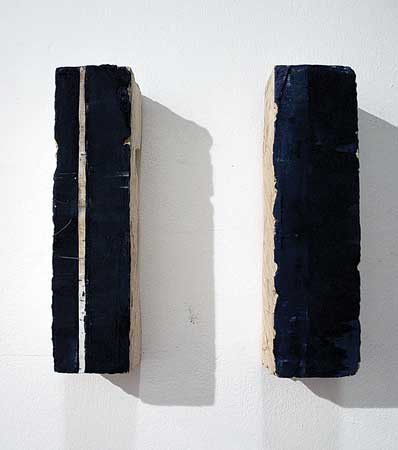Perla Krauze
Howard Scott Gallery
Howard Scott has been exhibiting for many years a trio of Latin American artists. On this occasion, he once again presents the work of one of them: Perla Krauze. It is a group of works that he selected during several personal and consecutive visits to Krauze’s studio. In the end, he chose twenty-two works, all of which were created this year. Before arriving at the exhibition area of the gallery, visitors are met by two small vertical stones partially painted black and placed on the wall next to the signage with the exhibition’s title. These parallelepiped-shaped sandstones—around 5 centimeters thick—have the natural sandstone color that contrasts with the intense black pigment that was applied to the frontal side of each piece. The hand-painted black oil pigment described three almost perfect triangles on the two stones—the paint in one of the stones was interrupted by an unpainted area of the work that vertically divided the stone from Oaxaca—the type of sedimentary rock often used for architectural coatings. The irregular lateral sides of both stones protrude like undulations directly produced by the cuts made by the stonecutter. These pair served as a signal, as an introduction to the abstract pictorials, and as an antithesis to what is going on inside the exhibition—where stretchers and canvases are organized according to their orthogonality, in a synthesis of Perla Krauze’s minimalist and landscapist approach.
Except for a pair of black works, the squares and the rectangles dance in the mostly white, greyish, and amber paintings. The external formats are almost square. They are inhabited by divisions in rectangular friezes that in turn are subdivided in the manner of a keyboard. In some paintings, the horizontal interruptions rendered by Krauze are more than just one. In some instances, she even uses the selvage of the linen to generate another geometric guard of soft tonal and textural gradation. The laterals are revealing because the frontal compositions on them alternate with zones in which certain parts end and others continue. Thus, from the interactions between wood and linen emerges a syncopated element. In the square and rectangular modules, two paintings that measure 1.80 cm high by 30 cm wide—one titled Memory and the other Traces, respectively—present viewers with the elongated formats that Krauze develops into free structures and paintings. There is a group of three small works—ranging from 15 x 15 cm to 20 x 20 cm—that independently and powerfully stand on their own, circumscribed to the same language that we are analyzing here. It is not the monumentality of the works that define the exhibition or the production by the author. It is the intimacy and the process during the elaboration time that creates the atmosphere in the works.
Wood is present in some contours, in a corner, among the pictorial friezes within the same work or in other sections. The paintings are not framed but all of the canvases have been stretched. Perla Krauze—who during an early period of her life was a textile artist—resignifies the meaning of the stretcher; repositions it and turns it into an expressive tool. Thus, it is possible to understand that the author connects her work with the skin and with an intimate structure that sometimes reveals itself. Staples and small nails unite the diverse sections. The works are inhabited by many layers of paint and many of them have been sanded, cleaned with a towel, and painted successively.
A comprehensive gaze through the gallery can perceive a sequence of neutral tones with subtle modulations and the cadence of medium formats. The general perception is one of the subtle nuances in a general context of the serenity of an exhibition basically resolved through oils, linen, charcoal, and graphite. It is important to reflect that in an exhibition of coetaneous painting—in which stripping and an emphasis on the process and the trace prevail—oil paint is rarely the essential and authorial material used. During Krauze’s solid development, experimenting, composing, intervening, accumulating, and interpolating were key factors. She relies on all types of materials, even resins, iron, lead, plastic and ceramic, to name a few. Nonetheless, she does utilize oils in the depths of the grain where the pictorial resides. Although visually the stretched fabric appears to have the body and treatment of canvas, it is actually linen. There resides that elegant and genuine intellectual rusticity that characterizes the paintings by Perla Krauze.

